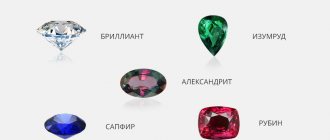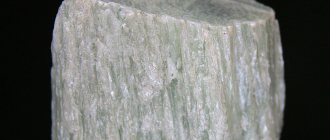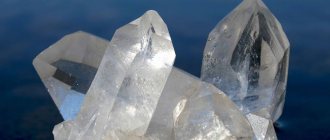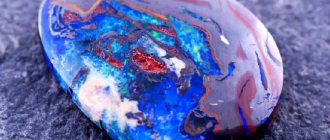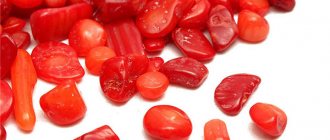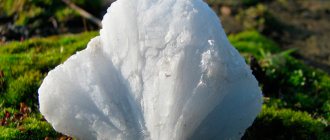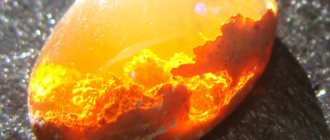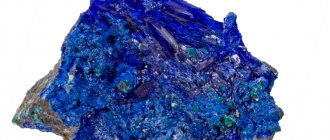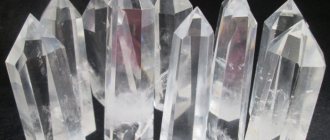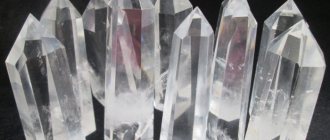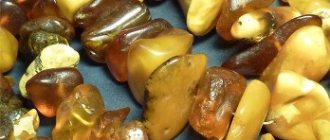History and origin
The first description of natural amber dates back to the 10th century BC. The priests of Ancient Egypt used organic stone for mummification, created incense burners from it, and performed the ritual of embalming the pharaohs.
Amber
In Rome, jewelry was made from the solar mineral for patricians. Greek warriors took products made from electrum (that’s what they called amber, translated as “shining”) as an amulet for battle. The healing properties of the stone were described by the great Hippocrates and Avicenna. Pliny and Biruni discovered the beneficial effects of the mineral on children.
Ancient peoples considered amber to be alive, animate, and associated it with protection and victory. Today, the magical properties of natural amber are in demand as a tool to counteract dark forces or improve human health.
The peak of popularity of amber accessories occurred in the 17th century. The most famous creation made of amber is the Amber Room from the chambers of Russian autocrats.
Amber deposits
The largest and most famous amber deposit is Palmnikenskoye in the village of Yantarny, in the Kaliningrad region. Extraction occurs with the help of water: powerful jets break up the soil in which amber deposits are located.
Advertising - Continued below
Amber is also found in small quantities abroad, including in the USA, Canada, Mexico, Romania and the Dominican Republic, where the rarest blue amber is also mined. Also, three fields operate on the territory of Ukraine.
Natural blue amber mined in the Dominican Republic. Photo: dominicanblueamberwholesale.com
Physicochemical characteristics
Amber is the hardened resin of coniferous trees. This is an amazingly beautiful stone of natural origin: its physical characteristics differ from other organic minerals.
| Formula | C10H16O+(H2S) |
| Color | Light yellow, brown, red, milky white, greenish |
| Shine | Smolyanoy |
| Transparency | Variable: from almost transparent to completely opaque |
| Hardness | 2-2,5 |
| Cleavage | Absent |
| Kink | Conchoidal; viscous (becomes brittle with aging) |
| Density | Typically 1.05-1.09, maximum 1.3 g/cm³ |
What determines the price of a mineral?
The price of the mineral depends on the size of the piece and its color.
The white variety of amber has long been considered the most valuable. Experts say that such specimens contain the least amount of impurities and have the most excellent healing properties.
The Chinese and Japanese prize a variety of cherry blossom called "dragon's blood." Such stones belonged to members of the ruling family.
The Emperor of Rome, Nero, preferred black amber.
The brightest fiery amber is found in Sicily.
The most expensive type is considered to be landscape, as well as mineral interspersed with particles of insects, animals, etc. Amber is known to contain a lizard inside. Such a copy has a cost of several tens of thousands of dollars. But such examples are quite rare.
In history, red amber was valued; later, golden amber was preferred.
In eastern countries, white varieties of the mineral were considered especially valuable, which were endowed with powerful healing powers.
Nowadays, a yellow mineral with a uniform color is considered high quality.
Varieties and colors
It is not without reason that amber is called the sun stone. Its classic color scheme is yellow-brownish. There are other shades and types of mineral. The structure and color of amber were created by natural factors of the period when conifer resin flowed onto the soil. From it the organic mineral was formed. The longer the pebble was in the sun or air, the brighter it is.
Colors
Gemologists and mineralologists have classified more than 300 colors and shades of gems - from white to black:
- yellow-brown is the most common;
- orange;
- red or the color of ripe cherry - called “dragon’s blood”, similar to a ruby, very rare, expensive;
- white - actually yellowish in color, the illusion of white color is created due to bubble inclusions;
- green - the color of the stone comes from sulfur pyrites or algae;
- colorless - transparent waxy mineral;
- blue - Dominican amber;
- black - dull-opaque, also known as jet.
Amber resin sometimes contains the remains of flora or fauna. Such inclusions increase the value of the stone. If the insects in the resin are larger than a centimeter, their owner can be considered rich.
Kinds
Minerologists divided amber into types. Each has different characteristics and features:
- bokkerite - a dense, elastic, opaque caramel-reddish gem;
Bokkerit - Glessite is an opaque brown stone with a minimum of impurities;
Glessite - gedanite - yellow, due to its fragility, processing of the mineral is impossible;
Gedanite - kissellite - yellow, olive, green agglomerates;
Kiscellite - kranzite - unripe amber;
Kranzit - stantienite - fragile, opaque black-brown stones;
Stanthienite - succinite - dark brown with a rich yellow center, the most common, high-quality type, characterized by a high percentage of succinic acid; recognized as a jewelry variety;
Succinite - shraufite - yellow-red, red color.
Shrawfit
The variety intermediate between succinite and gedanite is called “rotten” (some people ignorantly call gedanite this way). “Naked” amber stands out - a dense, unweathered stone, polished with sand from the bottom of the sea. Retained the original color or darkened a little, becoming reddish. The value of amber is influenced by the degree of transparency. It is due to different concentrations of microvoids in the mineral.
Formally, amber is an ornamental stone, but it is pleasant to look at.
Types and colors
The familiar honey-colored pebble is just one of the varieties of sun stone. Each type of amber has its own name. Perhaps this is what confuses people - many do not know that other shades are found in nature.
The warm gem we are used to, in which the sun has settled, is actually called succinite. This is what is usually meant when people talk about amber.
Main varieties:
- Red. Among the shades of red there are not only scarlet, but also cherry. Externally, the mineral rather resembles the recognized king of gems - ruby. This species has a poetic name - dragon's blood.
- Green. It appeared due to the inclusion of pieces of soil and grass in the resin.
- Lactic. The title is misleading. Its color is not at all milky or even white, but yellowish.
- Black. He's a centenite. A very unattractive variety, reminiscent of frozen lava.
Medicinal properties
The healing properties of amber and who can benefit from wearing it were discovered by healers thousands of years ago. It has been established that the mineral is able to overcome any pathology and will be useful for the body of a healthy person. The beneficial properties of natural amber manifest themselves in different cases:
- The stone improves brain function.
- Optimizes metabolic processes in the body, therefore it is used in the fight against excess weight.
- Used to prevent or combat colds.
- For respiratory problems, amber in a necklace or brooch is suitable.
- Earrings with green mineral improve hearing and vision.
- Short beads made of unprocessed amber are useful to wear for pathologies of the thyroid gland.
- Wearing amber body jewelry (pendant, bracelet, beads) relieves skin rashes.
- For the treatment of hepatitis, gastrointestinal tract, cardiovascular, and nervous systems, take a green stone.
It is effective to use bracelets, necklaces, and rings for treatment. Jewelry with a stone will make a healthy person more cheerful and optimistic.
The healing properties of the stone apply to everyone; there are no contraindications. But if during treatment there is dizziness, discomfort, tingling at the application sites, the stones are removed.
The properties of amber are most convincingly demonstrated by dark, medium-sized minerals.
Who will benefit from the stone?
Earrings with large faceted drops of amber and hessonites from Lilly Hastedt
Amber is a unique link between the past and the present, a keeper of the memory of times distant and almost inaccessible to study. That is why the stone is considered the most successful talisman for those whose life and work are directly related to the study of bygone days - archaeologists, geologists, philosophy teachers and historians.
Advertising - Continued below
Magic properties
Alchemists used amber powder to make the elixir of eternal youth. The Slavs wore beads made from the mineral as protection from the evil eye. Crushed stone is still used in churches today to create the desired mood.
The magical properties of the stone are beyond doubt among modern lithotherapists.
- The golden mineral is the embodiment of joy and fun. It pulls the owner out of hopeless melancholy, gives peace, and drives away thoughts of past hardships.
- Black stone is taken on the road to make the trip or business trip easy and successful.
- This same gem sharpens the owner’s intuition and suggests the right decision.
- Amber stone is a woman’s guardian, helping to bear and give birth to a healthy baby.
- Green beads on a red thread are placed in a baby’s stroller or crib from the moment of birth as a shield against the evil eye or trouble.
- The mineral is a powerful home amulet. Protects from the elements, intruders, neutralizes black magic.
- Amber substances restore youth, therefore they are popular among both sexes.
The stone retards the owner’s ailments. The appearance of cracks or other defects means that danger awaits the owner. This is especially important for people in risky professions. Cloudiness signals a person’s illness.
Even the ancient Greeks presented amber items to loved ones or friends as wishes for happiness. This significance of the stone remains today. The gem is worthily appreciated by all people, regardless of age or gender.
A silver ring with jet is considered a talisman for doctors or scientists, copper accessories with black amber - for sorcerers and magicians.
Ring with amber
The raw mineral, especially the black one, is the strongest. Sorcerers are confident in the magic of the gem: it protects a person and the house, repels negativity, and imparts determination.
Simple pebbles are better suited as amulets or talismans.
Properties of the magic stone amber
Our ancestors loved nature and turned to it for help. Due to its magical origin, from the resin of trees, amber stone is interesting for its mystical properties and background. Despite the external hardness, the material is malleable; the product can be given any shape for decoration. When burned or rubbed, it emits the smell of resin, which is valued in esotericism during various rituals.
The magic stone is able to absorb negativity and transform it into positivity.
Doctors treated diseases with the mineral. The magical and healing properties of white amber were considered pure and strong.
Healing
Doctors believed that there were no ailments for which amber would not help. It does not have fast healing and magical energy; it removes sores over time.
In medicine, the properties of magical amber are used in the treatment of diseases:
- For sore throat, toothache, headache due to magnetic storms, the stone will be useful.
- The use of antihypertensive drugs will be reduced.
- There will be no disruption in the functioning of the heart and blood vessels; it fights varicose veins in the lower extremities.
- The positive magical effect of amber has been noted on the human glandular environment: blood, lymph, interstitial fluid.
- Used in the treatment of the musculoskeletal system, normalizing joint function.
- Magical properties are used in oncology: it inhibits pathological cell proliferation.
- Used in the treatment of benign and malignant neoplasms.
- Amber contains iodine; it is useful to wear beads, necklaces, pendants for various ailments of the thyroid gland caused by iodine deficiency.
- The mineral contains salts and acids that help activate metabolism and normalize the digestive system, which has a positive effect on weight loss and maintaining the achieved result.
- Acids calm neuropsychic activity, relieve irritability and anxiety, and improve sleep.
In Poland, a tincture is made from the solar magical gem; its properties help with diseases of the upper respiratory tract.
Amber plates are given to young children as their teeth grow.
If you use a mouthpiece made of magical amber when smoking, you can reduce the risk of cancer.
Magical
The stone has always been considered a symbol of happiness, love, family well-being, and mutual understanding. The magic of amber is diverse: its properties brought good luck, power, home peace, and gave confidence in the undertakings started.
Stone experts recommend wearing jewelry with a solar gem to creative people and individuals working in the creative field. The properties of the mineral are useful for pregnant women and contribute to a successful delivery. If a woman wears amber beads while breastfeeding, the baby will become joyful.
Do you need the help of magical powers?
Get an answer to your burning question from a magician and healer. Write about the problem right now, and an expert will suggest a solution online!
Ask a free question View all questions
A piece of a magical gem with special properties was placed face down near the pillow to ward off otherworldly forces. Items made of amber protected the house from lightning and fires.
The yellow gem symbolizes spiritual connection; when burned, it emits the smell of tree resin.
Who is suitable according to their zodiac sign?
Amber and some zodiac signs are especially friendly. But this semi-precious solar stone suits almost everyone's horoscope.
If the stone is contraindicated according to your zodiac sign, astrologers advise wearing jewelry made from pressed or carefully processed material. The magical properties of such amber are weaker.
| Zodiac sign | Compatibility (“+++” – fits perfectly, “+” – can be worn, “-” – strictly contraindicated) |
| Aries | + |
| Taurus | — |
| Twins | + |
| Cancer | + |
| a lion | +++ |
| Virgo | + |
| Scales | + |
| Scorpion | + |
| Sagittarius | + |
| Capricorn | + |
| Aquarius | + |
| Fish | + |
(“+++” – fits perfectly, “+” – can be worn, “-” – is strictly contraindicated)
The use of amber in jewelry
The gem belongs to the type of minerals, the type of cutting for which is cabochon (semicircular shape) or simple grinding. This is due to increased fragility, internal voids and, as a result, large losses in carat (weight) during processing, the likelihood of splitting and cracks in the gem.
This is unacceptable for jewelry, since amber deposits are significantly depleted every year, and the chance of finding a large stone is negligible.
Application area
Amber raw materials are used in various industries: jewelry, arts and crafts, and industry. The distribution is influenced by the assessment of amber according to its main characteristics.
Jewelry
The main area of application of the mineral. A jewelry stone in jewelry ideally complements silver, gold or platinum, as if “warming” precious but cold metals.
The properties of amber make it unsuitable for automatic operations; jewelry or products are made manually. Granite is rare; more often the processing is minimal, in the form of cabochons or soft fantasy shapes.
Silver jewelry with light stones suits a young girl. Cognac-honey, cherry or brownish specimens in gold are an attribute of a mature lady. A black stone in a white frame is suitable for men.
Silver earrings with amber
The cost of amber allows you to assemble a set of jewelry according to the type or color of the stone.
Arts and crafts
Mineral fragments are pressed into agglomerates used in art. Designers and stone-cutters create products of any size and complexity of processing. People are happy to buy sculptures, boxes, ashtrays, chess, watches, and dishes. Gizmos perform utilitarian and aesthetic functions.
The use of amber is waste-free. Amber multi-colored crumbs are used to “paint” paintings and icons. The rich color scheme of stone fragments, especially the yellow range, allows for accurate paint rendering.
Other areas
The mineral is present in medicine (medicines, medical devices). In industry, it is used to produce excellent insulating material, enamels, and components of chemical complex products. Amber raw materials are purchased by agriculture.
Price
The price of amber is calculated per gram. The cost is determined by the type, quality, weight of the stone ($5–97 per gram). More valuable than others are thick reddish, blue, and green amber. Yellowish or pressed specimens cost no more than $16 per gram.
Rosary from amber
This is a raw material for jewelry or ordinary souvenirs. The price of paintings depends on the size and amount of material (from 1.2 thousand rubles). For individual works of authorship they ask for 110–140 thousand rubles.
Density
Professionals and lovers of the mineral are often interested in the question of what the density of amber is. This property should be discussed in more detail.
The mineral amber, whose density is 0.97-1.10, is comparable in this characteristic to sea water. That is, sea water has the same density. Therefore, in the sea, the stone floats to the top, and in fresh water, vice versa. That is why the mineral is so stable and does not wear off for many millions of years.
In the sea, pieces of amber float freely on top. Unaltered amber has a density in the range from 1 to 1.18 g/cm³. It is measured by weighing in a heavy liquid. In the Lviv region there is amber, the density of which is greatest. It is 1.14. In Ciscarpathia and Primorye, the density of amber is much less. Experts determine it in the range of 1.04-1.1 g/cm3.
What is the density of amber in altered specimens? This parameter is much higher in weathered minerals. It is 1.08 g/cm³. The density of the brown weathering crust itself is 116 g/cm³. The highest density of amber in g/cm3 of weathered specimens was noted in stones from the Ciscarpathian region; it is equal to 1.15-1.22.
What does this value depend on? In some cases, the density of the stone is directly related to the presence of impurities in it. It can be iron, nitrogen, sulfur, aluminum. In stones with iron impurities, the highest density of amber is recorded; in kg/m3 it is 1220. However, in other cases, the exact opposite relationship is observed. When experts measured the density of amber in the vicinity of Lviv, the opposite situation was recorded. From these data, scientists came to the conclusion that the density of the mineral is determined by the composition of the resin from which the stone was formed.
Thus, the average density of amber is 1100 kg/m³, this is the value accepted by physicists and chemists in their calculations.
How to spot a fake
The market is filled with amber of varying quality and origin.
Types of imitations
The raw material for the production of amber assortment is artificial or natural material, very similar to a real gem.
The highest quality imitations:
- copal - fossilized resin of peas, beans, chickpeas, and other legumes;
- Bernite is a coarse amber powder bonded with epoxy resin and heat-treated.
dug
Visually, the falsification copies a natural gem.
Identification rules
The origin of a sample can be determined by the following characteristics:
- natural stone has a rich color;
- natural mineral feels warm and pleasant to the touch;
- real amber does not smell (fake amber may have a forest or herbal aroma);
- when heated, the natural mineral emits a light pine or clove smell (the imitation smells like a pharmacy);
- natural stone rubbed on clothes attracts threads, paper, ashes, hair;
- an amber piece floats in salt water, and sinks in fresh water;
- amber glows under ultraviolet light;
- Only fakes made from young resins will have a needle mark on the surface.
Organic formations contain round air bubbles inside (in the fake they are elongated), their shade changes smoothly (in the imitation they are clumps of contrasting inclusions).
If it is difficult to distinguish a fake on your own, it is better to contact an expert. Especially when purchasing large or expensive items.
Forms of mineral in nature
In nature, future amber is found in the form of formations of any size in the following places:
- on the trunks after the resin flows through the tree,
- under tree bark, in hollows and other voids.
Near-surface discharge occurs in the form of drop-shaped deposits and plates with inclusions and marks of branches, bark, and tree trunk.
Discharges from the intra-trunk areas are concave plates with narrow edges.
Under natural conditions, the mineral is covered with a dark crust. Its thickness is from 1 to 4 mm. When not completely processed, the stone often acquires an interesting color. The weathering crust protects the mineral for many years.
Secondary forms of resinous secretions, which were formed in sea and river waters, under glacial and geological conditions, are smaller in size compared to the primary ones.
The mass of the amber pieces found can range from a few fractions of a gram to ten or more kilograms.
The largest amber is in the London History Museum, its mass is 15 kg 250 grams.
How to wear and care
The mineral is not particularly durable and requires delicate care:
- jewelry or products are stored in durable packaging or a box;
- from falls or impacts, the stone may chip or collapse;
- keep the gem away from metal or sharp products, heating appliances;
- sudden temperature changes have a bad effect on the structure of the mineral;
- amber jewelry is worn when cosmetics and perfumes have been absorbed;
- does not tolerate fat, household chemicals;
- dirty fingers will leave stains on the stone;
- dryness causes the pebble to become covered with microcracks or crumble, so frequent bathing or wet wraps are helpful.
The contaminated gem is immersed in clean or salted water for 15–20 minutes. Soap or chemicals are prohibited. Dry with a soft cloth (a hair dryer or sun will cause the amber to darken or fade).
Amulet from amber
If possible, buy a special cleaning composition. Restoring the shine and richness of amber:
- the mineral is left in salt water overnight;
- air dry for 25–30 minutes in the morning;
- immerse in warm olive oil for soaking for 20–25 minutes;
- take out and polish with a soft cloth.
You can cover the clouded gem with paraffin and tooth powder. Wipe off any dried mixture residue with a soft cloth. The mineral becomes cloudy from harsh ultraviolet radiation; jewelry with it should not be worn in direct sunlight. However, gentle sunbathing is beneficial: amber is recharged energetically and shines brighter. At the same time, the accumulated negative energy goes away.
Organic stone is fragile, you need to wear jewelry carefully (especially a ring or bracelet).
Application of amber in industry
In industry:
- amber is processed into succinic acid, rosin (for soldering), and oil. For these purposes, waste from jewelry concerns or contaminated resin (substandard) is used;
- use of amber for the production of amber varnish. Ideal for increasing surface resistance, isolate in technology. Used as a wood preservative in shipbuilding and woodworking;
- as a binder in the production of sandpaper.
This is interesting! The famous violins of virtuosos Amatti and Stradivari have retained their sound to this day precisely because they were treated with amber varnish.
What is amber
The golden resin of prehistoric trees, which contains fragments of ancient insects and plants, air bubbles or other inclusions, is called amber. In Belarus and Ukraine the stone is called “burshtyn”, and in most European languages they use the French word “amber”, a derivative of the Arabic name.
Nature of amber
The oldest sample of amber is more than 100 million years old, and the famous gemologist Vladimir Valentinovich Bukanov, who devoted his entire life to the study of stones, wrote in the book “Colored Stones: Encyclopedia” that, according to various estimates, the age of amber is 65–250 million years.
Name compatibility
Male: Alexey, Alexander, Anton, Afanasy, Valentin, Valery, Vasily, Victor, Vladimir, Georgy, Denis, Dmitry, Emelyan, Efim, Ivan, Ilya, Irakli, Cyril, Cyprian, Claudius, Constantine, Lazar, Leonty, Mark, Mikhail, Nikifor, Nikolai, Pavel, Roman, Sergei, Taras, Feodosius, Julian.
Women's: Alexandra, Alina, Anastasia, Vasilisa, Galina, Natalya, Nika.
But be sure to take into account your birth period. The overall meaning of the stone according to zodiac parameters suggests that Capricorn Michael should definitely not wear amber. At the same time, the gem is highly recommended for Aries Mikhail.
Compatibility with other minerals
Amber products
Amber is a nugget of Fire. This means that it is absolutely incompatible with Water or Earth. The mineral will suppress earthly energy, and with the water element the effect of mutual destruction is created.
Water minerals are Chrysolite, Alexandrite, Opal, Adularia, Topaz and Emerald.
Earth Stones – Malachite, Turquoise, Jasper, Jadeite and Sardonyx.
Fire brothers:
- pyrite,
- coral,
- zircon,
- spinel,
- pyrope,
- heliodor,
- diamond.
Astrological incompatibility, according to Pavel Globa, is between amber and ruby and hematite, despite the fact that ruby is a stone of Fire.
